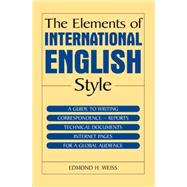| Preface | xi | ||||
| Acknowledgments | xvii | ||||
| 1. The Language of Global Business Is International English | 3 | (12) | |||
|
3 | (1) | |||
|
4 | (7) | |||
|
11 | (2) | |||
|
13 | (1) | |||
|
14 | (1) | |||
| 2. Principles of Simplicity | 15 | (23) | |||
|
15 | (2) | |||
|
17 | (19) | |||
|
18 | (1) | |||
|
19 | (1) | |||
|
19 | (2) | |||
|
21 | (3) | |||
|
24 | (1) | |||
|
25 | (1) | |||
|
26 | (2) | |||
|
28 | (1) | |||
|
29 | (1) | |||
|
30 | (2) | |||
|
32 | (1) | |||
|
33 | (3) | |||
|
36 | (1) | |||
|
36 | (2) | |||
| 3. Principles of Clarity | 38 | (25) | |||
|
38 | (23) | |||
|
40 | (2) | |||
|
42 | (1) | |||
|
43 | (2) | |||
|
45 | (1) | |||
|
46 | (1) | |||
|
46 | (1) | |||
|
47 | (1) | |||
|
48 | (1) | |||
|
48 | (2) | |||
|
50 | (1) | |||
|
51 | (1) | |||
|
51 | (1) | |||
|
52 | (1) | |||
|
53 | (2) | |||
|
55 | (1) | |||
|
56 | (1) | |||
|
57 | (1) | |||
|
58 | (1) | |||
|
59 | (1) | |||
|
60 | (1) | |||
|
61 | (1) | |||
|
62 | (1) | |||
| 4. Reducing Burdens | 63 | (30) | |||
|
63 | (6) | |||
|
65 | (1) | |||
|
66 | (1) | |||
|
67 | (1) | |||
|
68 | (1) | |||
|
69 | (8) | |||
|
72 | (1) | |||
|
73 | (2) | |||
|
75 | (2) | |||
|
77 | (13) | |||
|
78 | (2) | |||
|
80 | (4) | |||
|
84 | (1) | |||
|
85 | (1) | |||
|
86 | (1) | |||
|
87 | (1) | |||
|
87 | (1) | |||
|
88 | (1) | |||
|
89 | (1) | |||
|
90 | (1) | |||
|
90 | (1) | |||
|
91 | (2) | |||
| 5. Writing for Translation | 93 | (12) | |||
|
93 | (2) | |||
|
95 | (2) | |||
|
97 | (2) | |||
|
99 | (4) | |||
|
103 | (1) | |||
|
104 | (1) | |||
| 6. Principles of Correspondence | 105 | (19) | |||
|
105 | (13) | |||
|
107 | (4) | |||
|
111 | (4) | |||
|
115 | (1) | |||
|
116 | (2) | |||
|
118 | (1) | |||
|
119 | (3) | |||
|
122 | (1) | |||
|
123 | (1) | |||
| 7. Principles of Cultural Adaptation | 124 | (17) | |||
|
124 | (11) | |||
|
127 | (2) | |||
|
129 | (2) | |||
|
131 | (2) | |||
|
133 | (1) | |||
|
133 | (2) | |||
|
135 | (4) | |||
|
139 | (1) | |||
|
140 | (1) | |||
| Appendixes | |||||
|
141 | (2) | |||
|
143 | (2) | |||
|
145 | (4) | |||
|
149 | (4) | |||
|
153 | (4) | |||
| Index | 157 |








